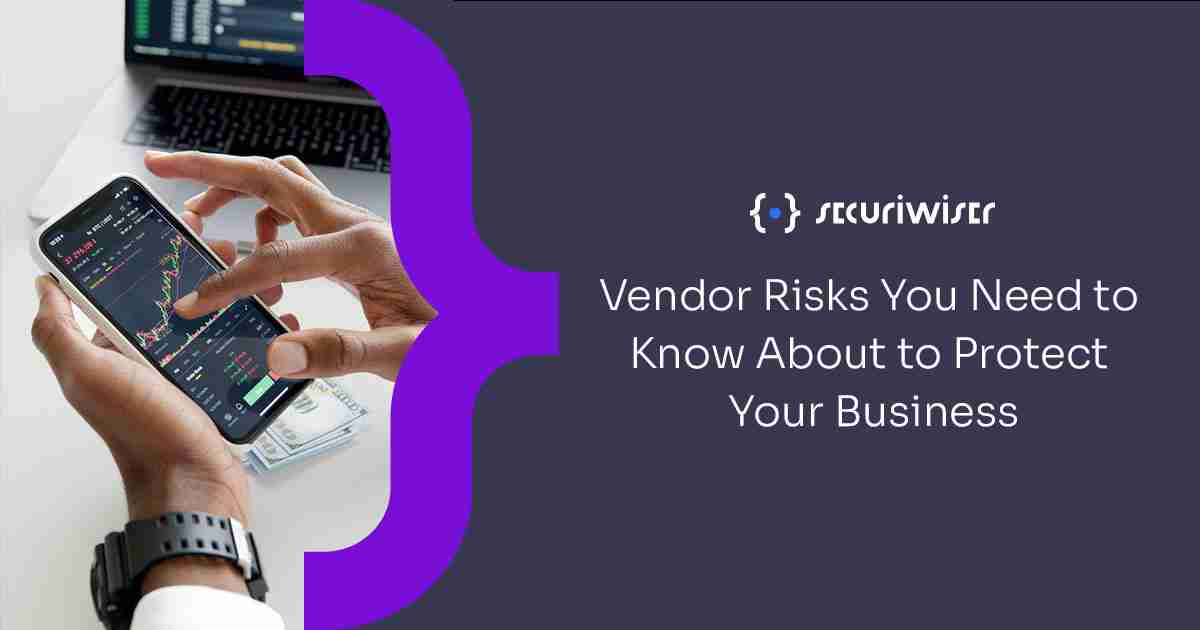Vendor Risks You Need to Know About to Protect Your Business
Blog / Vendor Risks You Need to Know About to Protect Your Business
4 MIN READ


Outsourcing and third-party vendors is a long-time business strategy that is cost-effective and has allowed many organisations to increase their operational efficiency tenfold by freeing up.
However, the way of the world is that everything has a cost, and cybersecurity is no exception. Vendors can have access to company’s critical systems and, by extension, their sensitive data. When Target suffered a massive data breach in 2013, where customer card details were compromised, it was because threat actors had gained access via a vendor for Target’s air and conditioning.
With 44 percent of vendors causing their clients business-altering data breaches, mitigating risk is key to the survival of your organisation.
Organisations need to know the types of risks that vendors pose in order to accurately perform third-party risk management and understand what the threats are. From there, they can cover their bases, prioritise, and come up with cybersecurity solutions to mitigate the danger and protect sensitive data.
Here are the different types of risk vendors pose that you need to be aware of.
Weak cybersecurity posture
With cyber threats and their sophistication continuously on the increase, monitoring your vendor’s cybersecurity posture is paramount to preventing your company from experiencing a cyber incident.
Not only do you need to evaluate and quantify your organisation's risk threshold and posture, but you need to do this for all vendors too. Vendors are a potential attack vector hackers can exploit to gain access to your systems and data.
It goes without saying, if your vendor doesn’t have robust cybersecurity performance, it will impact on your own.
With 82 percent of businesses giving their vendors access to all their cloud data, despite the majority of cases showing most permissions were not needed for the vendor to do their day-to-day activities, this can be especially devastating if an attack occurs.
Operations
Business operations are the life-blood of the company, keeping things churning day-to-day. However, third-party vendors are part of these operations and they can be a major part. Threat actors are very aware of this, making third-party vendors an excellent attack vector for denial of service.
When TSMC, a central vendor for Apple that manufactures SOC components for iPhones and iPads, suffered a cyber attack in 2018, this consequently impacted on Apple’s operations.
With supply chain attacks set to quadruple in 2021 alone, it becomes now more important than ever for companies to try to mitigate operational risk caused by vendors.
It’s highly recommended that your organisation creates a business continuity plan ahead of time to outline how your company will deal with a vendor shutdown and be able to remain operational and mitigate financial impacts.
Compliance
Vendors can also pose a compliance risk to your organisation. Compliance risks concern violations of laws, regulations, and internal process benchmarks that your company has to legally follow in order to conduct business.
These laws will often vary from sector to sector, although there are some commonly-applied regulations like General Data Protection Regulation (GDPR) and Payment Card Industry Data Security Standard (PCI DSS).
Non-compliance can often result in legal challenges and financial impacts. Your company may suffer substantial fines and reputational damage, which makes it absolutely crucial you make sure your vendor’s cybersecurity compliance aligns with your business regulatory requirements. Amazon was given a GDPR fine of over 800 million dollars, and other companies have suffered similar fates for non-compliance.
In regards to third parties, compliance issues can often come about when vendors make business decisions that don’t align with your own organisation’s strategic objectives. In order to mitigate strategic risk, you need insight into your vendors’ operations, processes and procedures. It’s important to establish key performance indicators (KPIs) to effectively monitor strategic risks and compliance issues which may crop up.
Reputation
Your reputation as a company can also be greatly damaged by cyber incidents related to third-party vendors. It’s important to note that this will blow-back on your company, even if the third-party vendor is the attack vector.
After all, you ultimately did choose to go into business with them, and the public perception will often be that you were negligent in vetting them and run along the idea of guilt by association.
Damages to your reputation can occur due to:
- Customer PIIs and other sensitive information exposed via data breaches.
- Found non-compliance with laws and regulations.
- Communications with vendors that may not have followed company and cybersecurity best practices.
With 87 percent of consumers saying they wouldn’t do business with a company they felt had security issues and at least 38 percent of organisations losing customers due to cybersecurity, customers are conscious these days of cyber threats.
Monitoring and managing vendor risk
Suffice to say, it’s important for organisations to keep an eye on who they do business with, especially their vendors. After identifying the type of risks a vendor poses, you need to come up with and implement solutions to safeguard your company.
Not only that, but you need a means to make sure that your vendors are maintaining cybersecurity best practices at all times.
Here are the top ways for mitigate and manage vendor risk:
- Doing third-party risk assessments and vendor questionnaires, which help organizations evaluate vendor attack vectors and the level of risk individual vendors pose. You need to align the evaluation parameters with your company’s risk threshold and should also use threat intelligence when creating assessments as it increases vendor system visibility and helps prioritise threats.
- Doing regular due diligence, the process of identifying and remediating third-party cyber risks. Organisations can use security data to get insight about their vendors’ cybersecurity and IT infrastructure. This should be done on an ongoing basis so organisations are aware of emerging, vendor-related risks.
- Establish contractual standards, where by, after a rigorous vetting process, you establish robust, contractual standards between you and your vendor that take into account performance, costs and compliance.
- Continual monitoring of third-party vendors, where by monitoring the right security metrics, your company can identify risks coming from vendors directly before they become a problem and also create vendor-specific incident response plans to facilitate remediation.
Continuous monitoring is an especially fundamental part of third-party vendor risk management. In cybersecurity, it’s all about checks and balances. You can’t really defend yourself against something you don’t know about, which is why actors with access to your systems and networks, legitimate or otherwise, need to be scrutinised and monitored for suspicious activity.
However, monitoring and keeping track of third-party cybersecurity risks can be very resource-intensive and overwhelming undertaking for a company, so making ‘outsourcing’ work to cybersecurity’s benefit is often the best strategy.
Securiwiser
Securiwiser is a cybersecurity threat detection monitoring tool that not only finds vulnerabilities and evaluates the robustness of your cybersecurity posture in real-time, 24-hour-7, but also evaluates the posture of your vendors as well.
Securiwiser can tell you if your permissions are allowing untrustworthy port access, if there’s misconfigurations with your cloud, you network and your DNS, how you rank overall cybersecurity-wise compared to your competitors, and much, much more.
Give yourself a free scan today!
Previous Article
Dangers Associated With Rootkit InfectionsHow secure is
your business?
Blog categories
How secure is
your business?